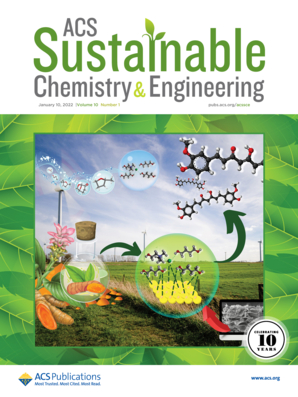Highly Dispersed Pd Nanoparticles Immobilized on N-Doped Hollow Carbon Spheres for Efficient Catalytic Hydrodeoxygenation of Biomass-Derived Vanillin under Atmospheric Conditions
IF 7.1
1区 化学
Q1 CHEMISTRY, MULTIDISCIPLINARY
引用次数: 0
Abstract
Catalytic hydrodeoxygenation (HDO) of bio-oil is an effective and challenging route to the efficient utilization of biomass with rich oxygen-containing groups. Herein, highly dispersed Pd nanoparticles (NPs) anchored on a N-doped hollow carbon sphere (NHCS) were constructed to effectively catalyze the chemoselective HDO of bio-oil-derived vanillin. The optimized Pd/NHCS-900 catalyst presented a high 99% conversion and 98% selectivity to 2-methoxy-4-methylphenol (MMP) within 45 min under very mild conditions of 50 °C and 1 atm H2. The incorporated N species in the NHCS support and its hierarchical porous structure facilitate the dispersion and stabilization of Pd NPs, resulting in the formation of highly dispersed Pd NPs with excellent structure stability. Moreover, the presence of a strong electronic metal–support interaction between N and highly dispersed Pd NPs produced the surface electron-rich active Pd NPs, which could enhance the adsorption and activation of reactants, thereby exhibiting high intrinsic catalytic activity with a large turnover frequency (TOF) of 1700.3 h–1. Kinetic study and density functional theory (DFT) calculations demonstrated the HDO reaction pathway and the corresponding reaction mechanism. These findings pave the way for the development of efficient and stable metal catalysts for sustainable biomass conversion.

氮掺杂空心碳球固定化高分散钯纳米粒子用于常压条件下生物质香兰素的高效催化加氢脱氧
生物油的催化加氢脱氧(HDO)是高效利用含氧基团丰富的生物质的有效途径。本文构建了高度分散的Pd纳米颗粒(NPs),锚定在n掺杂的空心碳球(NHCS)上,以有效催化生物油衍生香兰素的化学选择性HDO。优化后的Pd/NHCS-900催化剂在50℃、1atm H2条件下,45 min内对2-甲氧基-4-甲基苯酚(MMP)的转化率高达99%,选择性高达98%。NHCS载体中加入的N种及其分层多孔结构促进了Pd NPs的分散和稳定,形成了高度分散的Pd NPs,具有优异的结构稳定性。此外,N与高度分散的Pd - NPs之间存在强烈的电子-金属载体相互作用,产生了表面富电子的活性Pd - NPs,增强了对反应物的吸附和活化,从而表现出较高的内在催化活性,TOF高达1700.3 h-1。动力学研究和密度泛函理论(DFT)计算证实了HDO反应途径和反应机理。这些发现为开发高效稳定的金属催化剂用于可持续生物质转化铺平了道路。
本文章由计算机程序翻译,如有差异,请以英文原文为准。
求助全文
约1分钟内获得全文
求助全文
来源期刊

ACS Sustainable Chemistry & Engineering
CHEMISTRY, MULTIDISCIPLINARY-ENGINEERING, CHEMICAL
CiteScore
13.80
自引率
4.80%
发文量
1470
审稿时长
1.7 months
期刊介绍:
ACS Sustainable Chemistry & Engineering is a prestigious weekly peer-reviewed scientific journal published by the American Chemical Society. Dedicated to advancing the principles of green chemistry and green engineering, it covers a wide array of research topics including green chemistry, green engineering, biomass, alternative energy, and life cycle assessment.
The journal welcomes submissions in various formats, including Letters, Articles, Features, and Perspectives (Reviews), that address the challenges of sustainability in the chemical enterprise and contribute to the advancement of sustainable practices. Join us in shaping the future of sustainable chemistry and engineering.
文献相关原料
公司名称
产品信息
阿拉丁
2-methoxy-4-methylphenol
阿拉丁
Vanillyl alcohol
阿拉丁
Vanillin
阿拉丁
2-methoxy-4-methylphenol
阿拉丁
Vanillyl alcohol
阿拉丁
Vanillin
 求助内容:
求助内容: 应助结果提醒方式:
应助结果提醒方式:


